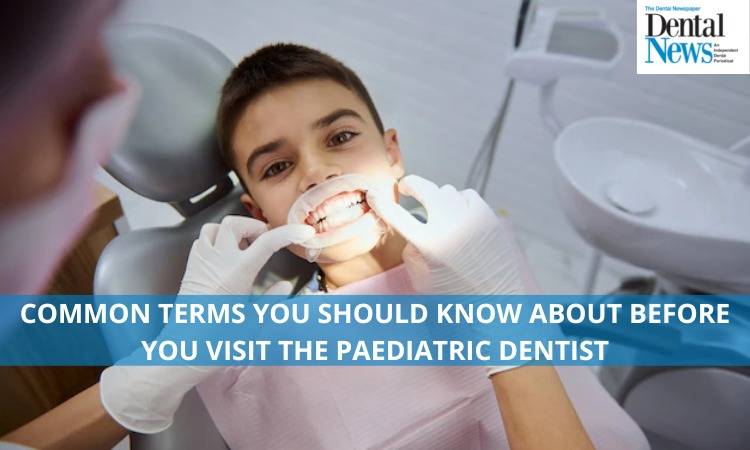
Paediatric dentistry is a branch of dental science that deals with the dental problems and treatments of children and teenagers. While consulting a pediatric dentist it is not uncommon to stress about different terminologies designated for different treatment approaches. Hence, it is always wise to read up a little beforehand and gain knowledge so you know what the dentist is talking about.
Here is a complete list of dental terms you must know before a visit to the pediatric dentist.
A
Abscess
It is an infection caused by caries, trauma or a gum infection which results in the formation of pus within the tooth.
Anaesthesia
A drug is injected into the gums to help relieve the pain before the dentist starts a dental treatment.
Apex
The root of the tooth is also the most common site for abscess formation.
B
Bridge
Consists of one or more artificial teeth which can be attached to your adjacent teeth.
Bruxism
The clenching or grinding of teeth, most commonly while sleeping.
C
Calculus
Plaque buildup that that can form on neglected or prone teeth, also known as tartar.
Canine
The pointy teeth are just behind the laterals.
Caries
Caries is another name for cavities or decayed teeth.
Cavity
A tiny hole in the tooth is caused by decay. This cavity is often cleaned and filled with a filling material.
Crown
An artificial cap made of porcelain or metal is used to cover the tooth.
D
Decalcification
Refers to the loss of calcium from the teeth. This can lead to brittle and chipped teeth.
Dentures
A set of artificial teeth is often given to children who lose their teeth prematurely to maintain the space.
Digital Radiograph
An image produced by projecting radiation. Radiographs can be of different types including bitewing, periapical and occlusal.
E
Endodontist
A dentist who specialises in the treatments of dental pulp including root canals.
Enamel
The white surface of the tooth above the gum level.
Extraction
The removal of a tooth or teeth.
Eruption
The process in which the tooth comes through the gum surface in the oral cavity.
F
Flouride
A chemical used to strengthen the enamel. It also prevents chances of cavities and can be taken both systematically and can be applied in topical form.
Filling
A mixture of chemicals is used to fill the cavities. It is available in different forms.
G
Gingivitis
Refers to the inflammation of gums around the roots of the teeth.
Gums
The firm flesh that surrounds the roots of the teeth extends to the floor of the mouth.
I
Impacted Tooth
It is a tooth that sits sideways below the gum line. The condition often occurs with wisdom teeth often requiring extraction due to a lack of its ability to erupt in the oral cavity.
Incisor
Incisors are flat, sharp-edged teeth in the front of the mouth.
L
Lateral
Lateral are small flat teeth located adjacent to the central
N
Night Guard
A night guard is a plastic mouthpiece worn at night. It prevents grinding of the teeth; also used to treat TMJ problems.
Nitrous Oxide
Sedative gas is mostly used in paediatric dentistry. It is mixed with oxygen and inhaled through a small mask that fits over the nose to produce a calming effect to relax children.
P
Pedodontist
A pedodontist is also known as a pediatric dentist who specializes in the treatment of
children’s teeth.
Periodontist
A dentist specializing in the treatment of gum disease.
Plaque
A sticky buildup of acids and bacteria causes tooth decay.
Posterior Teeth
The teeth are located in the back of the mouth.
Primary Teeth
A primary tooth is a term used for “baby teeth”.
Prosthodontist
A dentist specializing in the restoration and replacement of missing teeth or severely damaged teeth.
Pulpotomy
Partial removal of pulpal tissue in cases of infection.
Pulpectomy
Complete removal of the pulpal tissues. It is a treatment commonly done in children.
Pulp Cap
Filling material is used to cover the small area of the exposed dental pulp.
R
Root
The portion of the tooth below the gum line is located inside the bone.
Root Canal
A process which requires the removal of infected pulp followed by the filling of the roots and crown to seal the cavity.
S
Sealant
It is a plastic coating applied to teeth to prevent decay. Used most commonly for children.
Secondary Teeth
Secondary teeth are a set of permanent teeth.
Spacers
Removable or fixed appliances designed to prevent tooth movement. They’re generally placed after extraction or in cases of teeth that were missing from birth. This allows new teeth to come into place and keeps the bite even (also called “space maintainers”).
Remembering these terms might sound a little overwhelming. However, getting to know atleast a handful of these can always do the trick.

Dr Rida Qamar
The author is contributing writer at Dental News Pakistan and can be reached at Ridaqamar100@gmail.com

